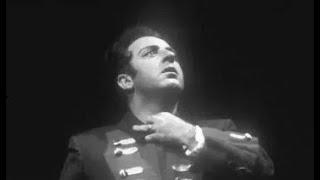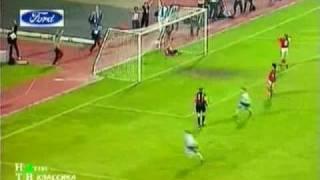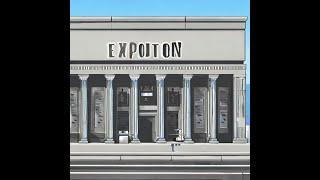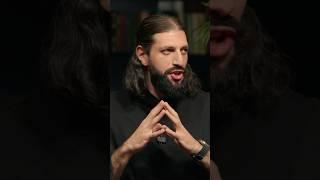
Carlo Bergonzi - Ô nature, pleine de grâce (Naples, 1969)
Carlo Bergonzi (1924-2014) was the last of the great tenors to emerge from post WWII Italy. His 50 year career in opera and concert took him to nearly every major theater in the world. Born near Parma, Bergonzi sang in church choirs and a few local opera productions as a child. He left school at age 11 to work with his father in the local cheese factory, often getting into trouble for singing on the job. At 16, he enrolled in the Arrigo Boito Conservatory in Parma, studying as a baritone. His studies were interrupted by the war and Bergonzi found himself in uniform, his opposition to the Nazis landing him in a German POW camp. After being liberated by the Red Army, the typhoid stricken, 80 pound Bergonzi spent a year recovering, resuming his studies at the Conservatory in 1946.
Sources disagree as to when Bergonzi made his operatic debut…Schaunard in a 1947 Catania La Bohème, Figaro in Barbiere di Siviglia in Varedo the same year and Figaro in Lecce in 1948. During the next few years, Bergonzi sang as a baritone, bouncing around the Italian provinces in such roles as Belcore in Elisir d’Amore, Sonora in Fanciulla del West, Marcello in La Bohème, Sharpless in Madama Butterfly and Enrico in Lucia di Lammermoor. He never felt completely comfortable, however, as a baritone, and began to consider a new path. Starting in 1950, Bergonzi essentially retrained his own voice, reemerging as a tenor the following year.
Bergonzi’s debut as a tenor occurred on January 18, 1951 at the Teatro Petruzzelli in Bari as Andrea Chénier. Reviews were glowing and the young tenor’s career took off quickly. He was invited to sing I Due Foscari in an RAI broadcast to commemorate the 50th anniversary of Verdi’s death and he became a fixture on Italian radio. Important debuts followed in Rome, Naples and Buenos Aires, with his La Scala debut in the title role in the world premiere of Jacopo Napoli’s Masaniello occurring on March 23, 1953. Turiddu served as the role for his U.S. debut in Chicago in 1955, and he took his first bow at the Met on November 13 of the following year as Radames. Over the course of 32 seasons, the tenor sang over 300 performances of 21 roles before taking his final bow as Edgardo on November 12, 1988. During those three decades, Bergonzi also graced the stages of Philadelphia, San Francisco, Mexico City, Caracas, London, Paris, Barcelona, Las Palmas, Lisbon, Monte Carlo, Verona, Turin, Bologna, Florence, Genoa, Munich, Vienna, Tokyo and other major opera centers.
It is a sad truth that Bergonzi remained before the public for far too long. Although his middle register never lost its bloom, the tenor began having difficulty with his top notes by the time he reached 50. He continued to appear, however, much to the delight of his fans. A LONG series of farewell recitals began in the 1990s and there was the ill advised attempt at one of the only major Verdi roles he had not yet sung, Otello. The tenor was well prepared for this Carnegie Hall performance in May 2000. As a member of that audience, I can attest to the fact that the old magic was still there at times. Bergonzi’s mid range sounded remarkably youthful, but in the end, the Moor was simply too much for the 76 year old tenor. Bergonzi bowed out after the 2nd act.
There were a few more recitals following the abortive Otello, but Bergonzi spent most of his time coaching young singers and holding court at his restaurant, I Due Foscari. Following a brief illness, Carlo Bergonzi passed away in Milan on July 25, 2014. He was 90.
During the post WWII era, a plethora of world class Italian tenors emerged from Italy, providing daunting competition for Carlo Bergonzi. His smooth, lirico-spinto instrument did not have the heroic ring of Corelli or del Monaco, nor did it have the caressing sweetness of di Stefano or Valletti. What Bergonzi did have was precise diction, nuanced phrasing and eloquent musicality. Even in his declining years, when the top notes were sometimes flat and strained, his years of experience and impeccable artistry made for absolutely breathtaking performances. Bergonzi’s repertoire of nearly 50 operas included Trovatore, Giovanna d’Arco, Luisa Miller, Attila, Forza del Destino, Simon Boccanegra, Ballo in Maschera, I Due Foscari, I Masnadieri, Il Corsaro, I Lombardi, Ernani, Oberto, Don Carlo, Tosca, La Bohème, Manon Lescaut, Edgar, Turandot, Il Tabarro, Pagliacci, Adriana Lecouvreur, Loreley, La Wally, La Gioconda, Mefistofele, Faust, Carmen, Werther, L’Elisir d’Amore, Norma, Jenůfa, Ifigenia, and Masaniello. His extensive catalogue of recordings, made for Decca, Philips, CBS, EMI, Sony and Orfeo, includes aria and song recitals, many complete operas and an array of live recordings. Here, Bergonzi sings “Ô nature, pleine de grâce” (or "O natura, di grazia piena" ias it's heard in Italian) from Massenet’s Werther. This was recorded live at the Teatro San Carlo in Naples on February 13, 1969, with Oliviero de Fabritiis conducting.
Sources disagree as to when Bergonzi made his operatic debut…Schaunard in a 1947 Catania La Bohème, Figaro in Barbiere di Siviglia in Varedo the same year and Figaro in Lecce in 1948. During the next few years, Bergonzi sang as a baritone, bouncing around the Italian provinces in such roles as Belcore in Elisir d’Amore, Sonora in Fanciulla del West, Marcello in La Bohème, Sharpless in Madama Butterfly and Enrico in Lucia di Lammermoor. He never felt completely comfortable, however, as a baritone, and began to consider a new path. Starting in 1950, Bergonzi essentially retrained his own voice, reemerging as a tenor the following year.
Bergonzi’s debut as a tenor occurred on January 18, 1951 at the Teatro Petruzzelli in Bari as Andrea Chénier. Reviews were glowing and the young tenor’s career took off quickly. He was invited to sing I Due Foscari in an RAI broadcast to commemorate the 50th anniversary of Verdi’s death and he became a fixture on Italian radio. Important debuts followed in Rome, Naples and Buenos Aires, with his La Scala debut in the title role in the world premiere of Jacopo Napoli’s Masaniello occurring on March 23, 1953. Turiddu served as the role for his U.S. debut in Chicago in 1955, and he took his first bow at the Met on November 13 of the following year as Radames. Over the course of 32 seasons, the tenor sang over 300 performances of 21 roles before taking his final bow as Edgardo on November 12, 1988. During those three decades, Bergonzi also graced the stages of Philadelphia, San Francisco, Mexico City, Caracas, London, Paris, Barcelona, Las Palmas, Lisbon, Monte Carlo, Verona, Turin, Bologna, Florence, Genoa, Munich, Vienna, Tokyo and other major opera centers.
It is a sad truth that Bergonzi remained before the public for far too long. Although his middle register never lost its bloom, the tenor began having difficulty with his top notes by the time he reached 50. He continued to appear, however, much to the delight of his fans. A LONG series of farewell recitals began in the 1990s and there was the ill advised attempt at one of the only major Verdi roles he had not yet sung, Otello. The tenor was well prepared for this Carnegie Hall performance in May 2000. As a member of that audience, I can attest to the fact that the old magic was still there at times. Bergonzi’s mid range sounded remarkably youthful, but in the end, the Moor was simply too much for the 76 year old tenor. Bergonzi bowed out after the 2nd act.
There were a few more recitals following the abortive Otello, but Bergonzi spent most of his time coaching young singers and holding court at his restaurant, I Due Foscari. Following a brief illness, Carlo Bergonzi passed away in Milan on July 25, 2014. He was 90.
During the post WWII era, a plethora of world class Italian tenors emerged from Italy, providing daunting competition for Carlo Bergonzi. His smooth, lirico-spinto instrument did not have the heroic ring of Corelli or del Monaco, nor did it have the caressing sweetness of di Stefano or Valletti. What Bergonzi did have was precise diction, nuanced phrasing and eloquent musicality. Even in his declining years, when the top notes were sometimes flat and strained, his years of experience and impeccable artistry made for absolutely breathtaking performances. Bergonzi’s repertoire of nearly 50 operas included Trovatore, Giovanna d’Arco, Luisa Miller, Attila, Forza del Destino, Simon Boccanegra, Ballo in Maschera, I Due Foscari, I Masnadieri, Il Corsaro, I Lombardi, Ernani, Oberto, Don Carlo, Tosca, La Bohème, Manon Lescaut, Edgar, Turandot, Il Tabarro, Pagliacci, Adriana Lecouvreur, Loreley, La Wally, La Gioconda, Mefistofele, Faust, Carmen, Werther, L’Elisir d’Amore, Norma, Jenůfa, Ifigenia, and Masaniello. His extensive catalogue of recordings, made for Decca, Philips, CBS, EMI, Sony and Orfeo, includes aria and song recitals, many complete operas and an array of live recordings. Here, Bergonzi sings “Ô nature, pleine de grâce” (or "O natura, di grazia piena" ias it's heard in Italian) from Massenet’s Werther. This was recorded live at the Teatro San Carlo in Naples on February 13, 1969, with Oliviero de Fabritiis conducting.
Комментарии:
Carlo Bergonzi - Ô nature, pleine de grâce (Naples, 1969)
Dead Tenors' Society
How a man should love a woman!
Tony Gaskins
TARROK [GOTHIC RAP] (+Eng subs)
• LarMoV •
Динамо Киев - Спартак Москва 1994
dynamofanat
ЗАНИМАЕМСЯ НЕПРИСТОЙНОСТЯМИ В PAYDAY2
Си Хэштегер
Чип дизеля от Reborn Technologies зло или благо?
AVM 500 (Алексей)


![TARROK [GOTHIC RAP] (+Eng subs) TARROK [GOTHIC RAP] (+Eng subs)](https://invideo.cc/img/upload/UTI2T1VIaExpaFQ.jpg)



![[Part - 3] Redux Form validation | Redux-form | Redux in React native tutorial for Beginners [Part - 3] Redux Form validation | Redux-form | Redux in React native tutorial for Beginners](https://invideo.cc/img/upload/bzltQzN6OEtYeEk.jpg)



















